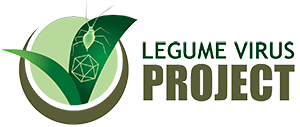This calculator is designed to estimate the net gains for insecticidal seed treatments for control of aphids and viruses in pea. The calculator estimates the anticipated benefits of the application in terms of economic returns, subtracts the cost of the seed treatment and returns a qualitative estimate of the return and classifies the result into 5 categories: substantial loss, moderate loss, neutral, moderate gain, substantial gain.
How the Calculator Works
Inputs
The benefits for treatment are estimated using 5 sources of information: 1) two years of field data in which untreated control plots were compared with insecticide treated plots of peas (var. Aragorn) into which plants infected with viruses (Pea enation mosaic virus or Bean leaf roll virus) (PEMV or BLRV) had been inserted as a source of infection, 2) two years of field data in which sets of plants of the same pea variety were inoculated with each virus and their yield compared with uninoculated controls, 3) estimates of the efficacy of seed treatments of Gaucho and Cruiser at labeled rates based on their effects on yield as compared with a triple spray of dimethoate designed to eliminate all aphids and virus, 4) a global risk of virus and aphid pressure based on 27 years of data on aphid and virus pressure and weather data from the Columbia Basin, 5) a local risk of virus incidence based on 5 years of data on the occurrence of virus at sites sampled throughout the Palouse region.
All the field trials for (1-3) were conducted at the Plant Science Farm in Moscow, ID from 2009-2011. Estimates (4 and 5) were based on our published and ongoing studies of pea aphid and virus incidence and abundance in the region. For more information see Clement S.L., Husebye D.S. & Eigenbrode S.D. (2010), "Ecological factors influencing pea aphid outbreaks in the US Pacific Northwest" in Aphid biodiversity under environmental change: patterns and processes, (eds. Kindlmann P, Dixon AFG & Houdková K). Springer Dordrecht, pp. 108-128, and the Legume Virus Project Interim Report (PDF, 26MB).
The costs for treatment are based on current values provided by suppliers, or these can be modified (entered on the calculator by the user).
Calculations
The efficacy of the seed treatments (3) was estimated as the proportion of the preventable yield loss (the difference between untreated plots and those receiving the 3x dimethoate spray) that was achieved by each seed treatment.
A dollar value for the benefits of each treatment is calculated as follows. The efficacy of the seed treatment (3) is multiplied by potential yield (entered on the calculator by the user) and the crop price (also entered by the user) to provide a dollar value of the benefit of a given seed treatment.
The net benefit of the treatment is estimated by subtracting the estimated cost from the benefit to return a dollar value.
Assumptions and Limitations
- Our controlled field plot studies have all used the variety Aragorn and have been conducted near Moscow, Idaho in 2009-2011. Different growing conditions and varieties will likely produce slightly different results than those produced by this calculator.
- Injury by viruses is estimated as the average of PEMV and BLRV from our field studies. This is because it is not possible at this time to readily distinguish the two viruses in the field and because combinations of PEMV and BLRV can also occur. This average of injury by the two viruses is therefore the best estimate of loss to virus and aphid possible at this time. In our studies, the injury by PEMV tends to be greater than that caused by BLRV, but PEMV also tends to be more prevalent in the Palouse region.
- Estimates of risk of virus infection on the landscape are based on surveys conducted each year of this project, with approximately 30 sites being surveyed in each year. Although this represents nearly 150 site – years, the resolution is somewhat course (9 mile square??). Individual fields close to one another may differ in likelihood of virus occurring, but our data cannot detect these differences.
- The project was designed specifically to anticipate aphid and virus "outbreak" years, but none has occurred since project initiation in 2008. It is possible that virus risk on the landscape differs substantially on such a year with the patterns we have documented during the interim years of this study.
- This calculator is just provided as a guide to assist producers in making decisions about seed treatments for pea. Conditions outside of those of our experimental and observational studies can cause different outcomes.
- This calculator ONLY considers the effects of seed treatment on benefits associated with seed treatments under pressure from aphids and viruses. Other benefits of seed treatments (e.g. protection from pea leaf weevil) have not been considered. Producers will likely wish to consider these other benefits and costs (if any) in making decisions about insecticidal seed treatments for pea.
